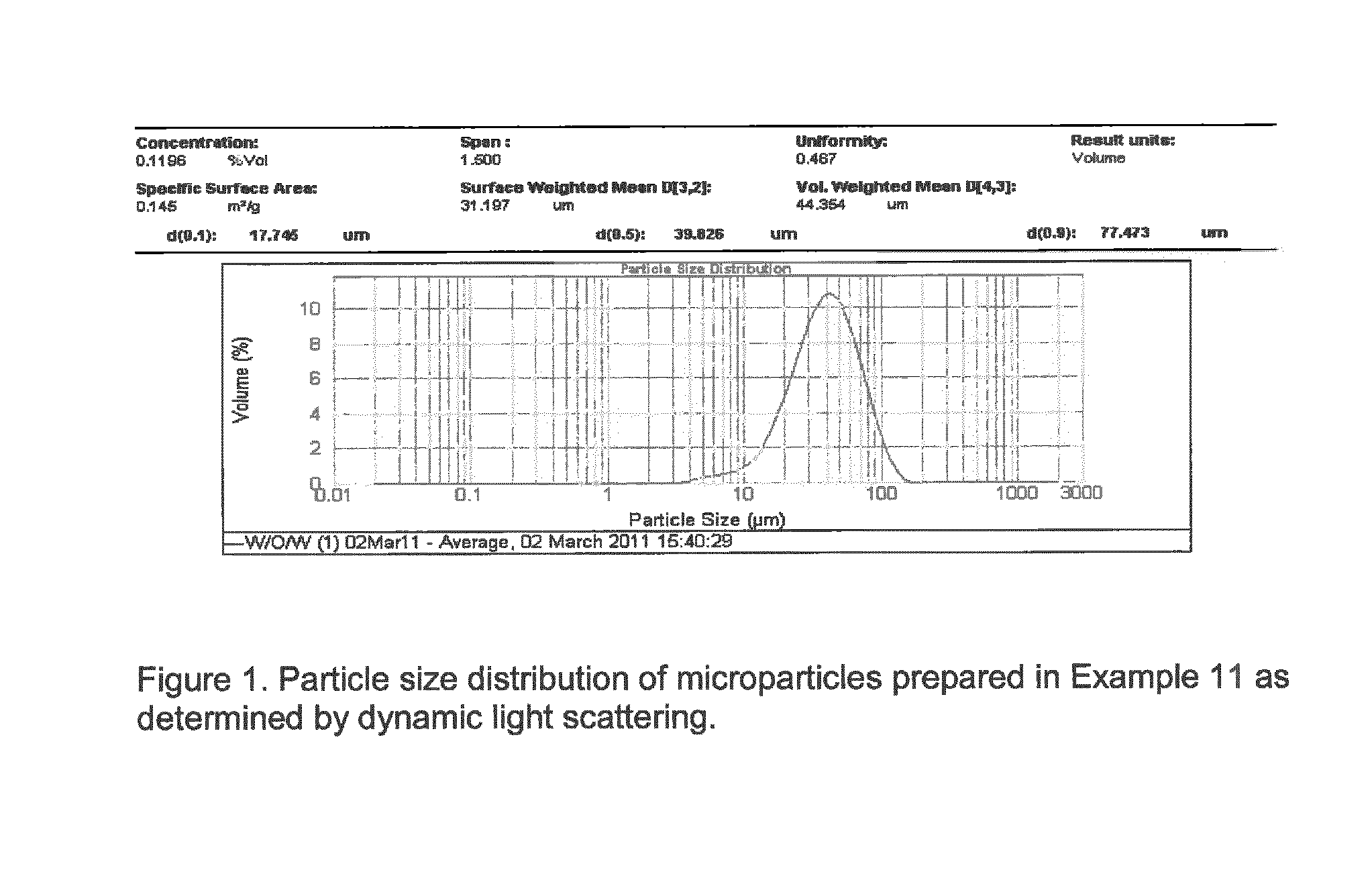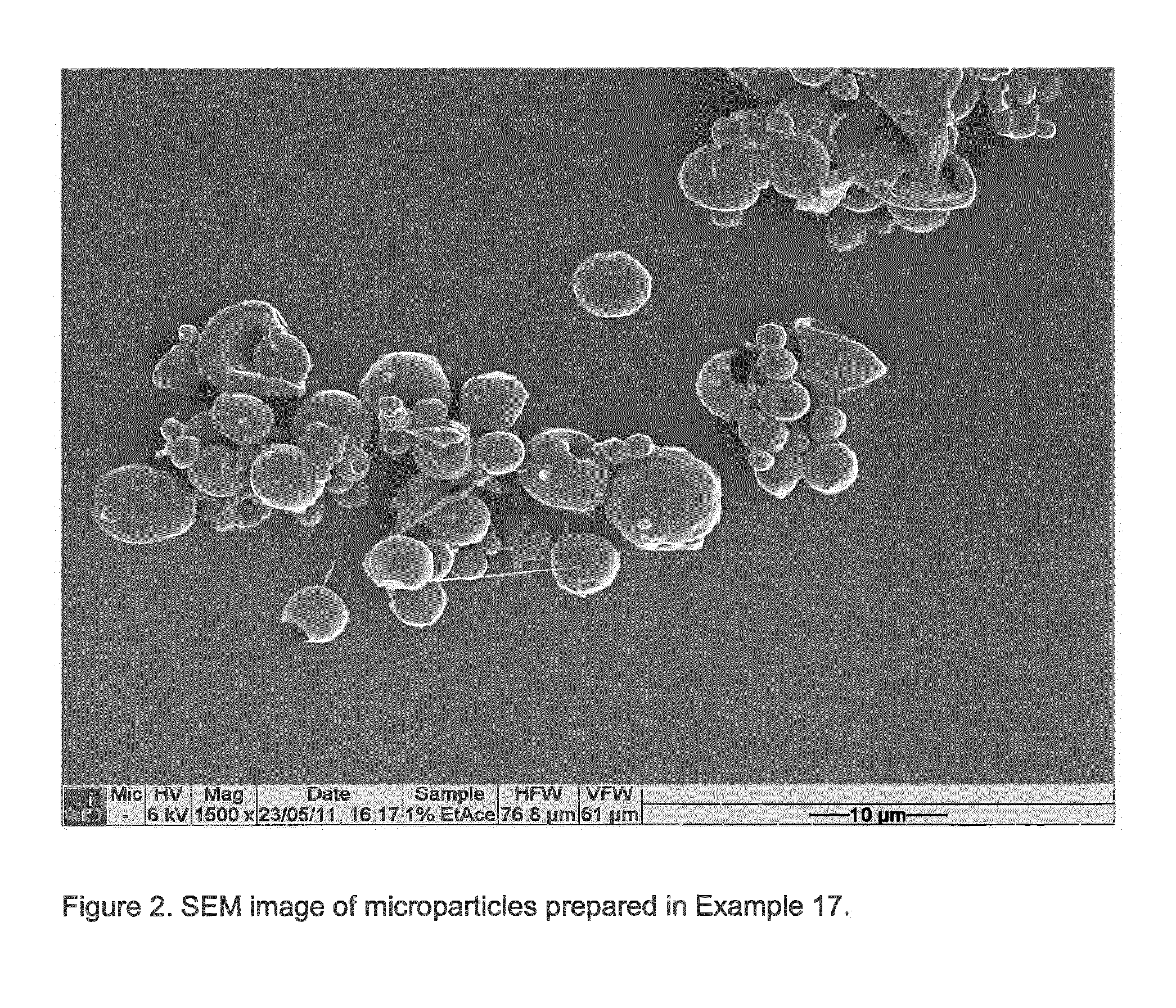Bioresorbable microparticles
a bioresorbable, polymer technology, applied in the direction of aerosol delivery, natural mineral layered products, metabolic disorders, etc., can solve the problems of long degradation time of polycaprolactone (24 months) which is usually a disadvantage for medical applications, and does not specifically disclose polymers, etc., to achieve the effect of increasing the degradation rate and reducing the degradation rate of caprolactone copolymers
- Summary
- Abstract
- Description
- Claims
- Application Information
AI Technical Summary
Benefits of technology
Problems solved by technology
Method used
Image
Examples
example 1
Manufacture of Linear Bioresorbable Prepolymers with Different Structure and Block Lengths for Subsequent Polyurethane Synthesis
[0077]The length of PEG block (400, 2000 and 8000 g / mol) and caprolactone block (500-3500 g / mol) was changed. The target pre-polymer molecular weight was selected to be between 7000-11 000 g / mol. Pre-polymer batch sizes were about 500-600 g. The pre-polymers were prepared by varying their compositions as follows (see Table 1): Batch A) Prepolymer A made of 32.01 g PEG 400 (16.0 mol-%), 561.58 g caprolactone (98.4 mol-%) and 0.608 g tin(II) octoate (0.03% mol-%), targeting a theoretical molecular weight of 7418 g / mol, Batch B) Prepolymer B made of 149.81 g PEG2000 (2.0 mol-%), 418.84 g caprolactone (97.9 mol-%) and 0.45 g tin(II)octoate (0.03 mol-%), targeting a theoretical molecular weight of 7592 g / mol, Batch C) Prepolymer C made of 461.93 g PEG8000 (10.0 mol-%). 59.30 g caprolactone (90.0 mol-%) and 0.07 g tin(II)octoate (0.03 mol-%), targeting a theoreti...
example 2
Manufacture of a Linear Bioresorbable Hydrogel Prepolymer and Polymer (Prepolymer A and Polymer 1)
[0079]Into a stirred tank reactor 32.01 g (16.0 mol-%) of dried PEG400 (MW 400 g / mol), 561.58 g caprolactone (98.4 mol-%) and 0.608 g (0.03 mol-%) tin(II) octoate were fed in that order. Dry nitrogen was continuously purged into the reactor. The reactor was pre-heated to 155° C. using an oil bath and a mixing speed of 60 rpm. PEG400 was dried and melted in a rota-evaporator prior to being added into the reactor. Then, ε-caprolactone was added and finally the catalyst tin(II) octoate. Prepolymerisation time for the PEG-PCL prepolymer was 5 hours. The theoretical molecular weight of the prepolymer was 7418 g / mol.
[0080]For the polymer preparation 6.60 g of low molecular weight poly(ε-caprolactone)diol (MW 530 g / mol) (PCLDI) and 90.2 g of the above mentioned prepolymer were dried and melted in a rota-evaporator prior to being added into the reactor. Dry nitrogen was continuously purged into...
example 3
Manufacture of a Linear Bioresorbable Polymer with a Different Structure
[0082]Prepolymer B (Table 1 in Example 1), and polycaprolactone diol (MW ˜530 g / mol) were mixed, dried and melted under vacuum at 90° C. for at least one hour prior to feeding them into the preheated (110° C.) reactor. Reaction mixture was mixed (75 rpm) under nitrogen. 1,4-butane diisocyanate was fed into the reactor. The molar ration between prepolymer, poly(ε-caprolactone)diol and BDI was 1:1:2. The reaction times was 13 minutes.
[0083]DSC analysis revealed that there were two glass transition temperatures (Tg) at −53.7 and 1.6° C. and the melting point (Tm) was 51.3° C.
PUM
| Property | Measurement | Unit |
|---|---|---|
| particle size | aaaaa | aaaaa |
| particle size | aaaaa | aaaaa |
| aerodynamic diameter | aaaaa | aaaaa |
Abstract
Description
Claims
Application Information
 Login to View More
Login to View More - R&D
- Intellectual Property
- Life Sciences
- Materials
- Tech Scout
- Unparalleled Data Quality
- Higher Quality Content
- 60% Fewer Hallucinations
Browse by: Latest US Patents, China's latest patents, Technical Efficacy Thesaurus, Application Domain, Technology Topic, Popular Technical Reports.
© 2025 PatSnap. All rights reserved.Legal|Privacy policy|Modern Slavery Act Transparency Statement|Sitemap|About US| Contact US: help@patsnap.com



